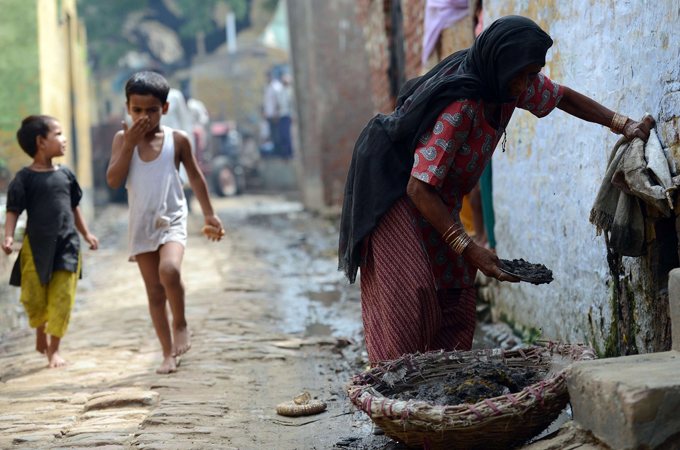
In India, the term ‘social distancing’ has a history that is closely associated with caste. The term ‘social distancing’ has historically been a practice that excludes Dalits from the centre of the city or village. This is done by geographically segregating places that Dalits are allowed to occupy. Studies have challenged the premise that urbanization erases caste boundaries. Meanwhile, spatial segregation remains an integral part of rural life, becoming a barrier for intra-village contact.
The concept of ritual purity derived from religious texts and notions of hygiene and cleanliness, as elaborated by Gupta et al., have become a Savarna[i]value, making it culturally constructed. These practices and ideologies have a bearing on how we use the term ‘social distancing’ during COVID-19 times in India.
When cleanliness and hygiene become a cultural construct, those perceived to be unclean are assumed to belong to a certain caste background. An example of this includes how domestic workers are treated in urban heterosexual, middle-class households, not just during the pandemic. Amita Baviskar and Raka Ray elucidate on the subtle ways in which domestic workers are separated from middle-class families by keeping separate plates for them.
During COVID-19 times, there were many reports of how domestic workers were seen as carriers of the virus. Baviskar and Ray further elaborate that the latter has also translated into allowing domestic workers to only take the stairs and not the lifts after the lockdown eased. Suraj Yengde, in his article on migrant workers, mentions that “out of the 395 million intra-state migrants in India, 62 million are estimated to be Dalits and 31 million Adivasis.” He further writes that their caste identity makes it harder for Dalit migrant workers to recover from the effects of the pandemic. While many move to the city for social mobility, Dalits move to escape untouchability and lack of accessibility to resources. This is further hindered because of the spatial segregation in metropolitan cities.
Kanthi Swaroop and Joel Lee, in their research conducted in Hyderabad and Lucknow, state that sewer workers die at a five times higher rate than other urban Indians, and from their fieldwork with sanitation workers, they mention that all sanitation workers are Dalit. According to them, the Brahmanical approach to the COVID-19 crisis is naturalizing the work based on the caste identity of the sanitation workers. About 49 sanitation workers lost their lives when the second wave of COVID-19 hit Delhi, and deaths of sanitation workers due to asphyxiation, their lack of access to healthcare and resistance to this callous treatment is seen in the form of protests. Swaroop and Lee mentioned that sanitation workers had not received adequate gear, PPE kits, masks, uniforms or even gloves as opposed to other government employees. According to them, this practice foregrounds an ontological connection between caste and occupation. This associates certain occupations with certain caste groups.
In this regard, Mary Douglas’s work ‘Purity and Danger’, published in 1966, is useful in understanding the concept of purity as cultural. One of the insights that Douglas’s work offers us is that the notions of hygiene and dirt are culturally constructed. According to Hilary Leathem, Douglas defines dirt in her work as a “matter out of place”, which is to say that the notion of dirt and how it is defined by society depends on the order of that particular society. There is no absolute definition of what dirt is. It depends on the particular cultural meanings given to it, making it contextual.
From this understanding, if we were to look at a society where the caste system is historically prevalent, the notion of what characterizes clean and unclean cannot be viewed without considering caste. As stated by Swaroop and Lee, when the directive to disinfect public spaces came in a town in Telangana, officials approached a Dalit man in the locality. Why is it so obvious to approach a Dalit in town when it comes to cleaning up dirt? It is a cultural phenomenon perceived as naturalized, as obvious by upper-caste authorities and those in power.
A reading of the phrase ‘Cleanliness is next to Godliness’, which is often taught in schools as a moral value and is used to emphasize not only habits to maintain personal hygiene but also that the cleanliness of character brings one closer to God. Thus, seemingly individual traits and morals translate into the predispositions of a certain society.
As mentioned by Dr B.R Ambedkar in ‘Annihilation of Caste’ written in 1936, Hindu religious texts have sanctified the hierarchical order of the caste system, deeming those at the top to be ‘pure’ and those and the bottom to be ‘impure’, cementing the occupational division of labour based on caste. The notion of ‘cleanliness’ thus, takes on a tangible and intangible meaning by assigning the quality of ‘pure’ and ‘impure’ to certain groups of people.
When we consider this, cleanliness or uncleanliness is not individual values but a collective imposition based on caste identity. The history of caste in India shows us that reading religious texts were limited to the Brahmans, and access to temples was restricted to Savarnas. Thus, in a society where the structure of caste is prevalent in every section, just like ‘cleanliness’, the quality of ‘Godliness’ too attains a dual meaning, that of being ‘pure’ and having direct access to God. Thus, the cultural construction of cleanliness informs the Brahmanical approach and overpowers scientific truth, especially during a pandemic. These associations reveal the casteist nature of our society and need to be examined critically and challenged as they reinforce social hierarchy and stigmatize identities.
[i] Savarna, in this case, means communities belonging to Brahman, Kshatriya, Vaishya, or Shudra varna in Dharma-shastras.
***
Shivani Chunekar is a research assistant at Monk Prayogshala and is studying Sociology at the University of Delhi. She is an aspiring researcher, and her research interests are in anti-caste thought, education, and social change.